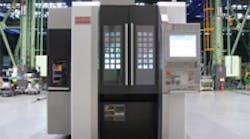For Mori Seiki, orders for machine tools have fallen off slightly since 2007, but the company is optimistic and preparing for the economic upswing it predicts will happen sometime around mid 2010.
“Now is a very good time for us to think about the future and to invest in it,” said Dr. Masahiko Mori, CEO of Mori Seiki. “Companies that have been working hard up until the recession should have some reserve funds available for such investments and should be focusing on the upswing.”
For Mori Seiki, investing for the economic upswing includes a new state-ofthe- art research and development center, several new and innovative machine designs, a new machine control system, and new pallet system software.
Mori Seiki recently opened its 70,000-sq-ft Digital Technology Laboratory (DTL) in Davis, Calif. The facility is both environmentally and technologically advanced, and features a dedicated thermal isolation chamber, vibration dampening floors, solar power and space to house dozens of machine tools along with a showroom and offices.
The facility has acquired a Leadership in Energy and Environmental Design (LEEDS) Gold Certification. That means the building not only conserves energy and water, it improves the health and safety for both occupants and the community at large.
Adam Hansel, president of DTL, said the facility is located close to Western U.S. customers and serves as the company’s West Coast/Mountain area headquarters.
But, most important, DTL conducts all the analysis of Mori Seiki machines, even those designed at the company’s facilities in Japan.
One notable machine design DTL analyzed was the company’s soon-to-be-released NMV-1500 5-axis vertical machining center. As the smallest machine in a series, the NMV-1500 is geared for high-level processing of small, complex five-axis parts, such as impellers. In fact, the company has already received requests for the machine from shops striving to reduce their impeller machining cycle times to less than five minutes per impeller, which the machine has accomplished in testing.
To achieve the fastest possible partprocessing times, Mori Seiki equipped the NMV-1500 with a 40,000-rpm spindle and optimized the machine’s structure and kinematics. DTL conducted extensive analysis on the NMV-1500 to optimize the machine to the greatest degree possible, and testing focused mainly on the dynamics and rigidity of the machine’s design.
The NMV-1500 will have a pallet system or the option for gantry loading from the top. It is a box-in-box construction that includes an octagonal ram and direct-drive motors in all its rotary axes.
Two other machines resulting from Mori Seiki’s investment in the upswing are the NMV-3000 DCG and the NT-1000. The NMV-3000 is the latest in the company’s multi-axis vertical machining center lineup. It builds on the highly successful design of the NMV-5000 DCG by providing both high-precision machining and ease of use in a compact machine platform. Its X-axis travels 19.68 in. to accommodate workpieces weighing as much as 220 lb.
As the smallest in Mori Seiki’s integrated NT Series machines, the NT-1000 mill-turn is a compact multi-tasking machine with a footprint measuring only 58 sq-ft. The machine is well suited for high-precision medical workpieces.
Another noteworthy machine is Mori Seiki’s NM-1000 ultra-precision machine. Mainly because it was developed entirely by DTL engineers and uses diamond milling or scribing tools to machine part features accurately in micron ranges and generates nanometer- level surface finishes.
On yet another machine technology note, Mori Seiki is offering what’s known as Zero-Chip technology. To eliminate the chip disposal and cleanup issues associated with bridgetype machines, a Zero-Chip system evacuates chips by sucking them up through the machine’s spindle right where the metal cutting takes place.
As investments in controls and software, Mori Seiki developed the MAPPS IV control system and LPS-III cell controller software. LPS-III, with an endof- 2009 release date, will help shops manage their pallet pool systems better. Innovative functions of the software include material management, fixture management, capacity planning, and improved manned/unmanned operations. With this software, Mori Seiki’s goal is not only to increase a shop’s spindle utilization, but also the throughput of parts that can be assembled, shipped and invoiced.
Mori Seiki’s new MAPPS IV control features both a built-in CAM system and post processor. The built-in Esprit CAM system, from DP Technology, comes standard for high-volume machines, and Mori Seiki will pre-install a proven post processor.
Also new to the control is the addition of vertical soft keys on the operator control panel for better operability, and there’s a button for CAM. Operators can do CAM simulations right at the machine.
Other MAPPS IV features are MAPPS ACT (advanced communication technology), which requires only one Ethernet/ IP cable to run other devices such as robots, Mori-Net advanced monitoring system that turns a PC into a plant controller and allows for remote maintenance that’s connected to Mori Seiki’s service center, e-mail notifications of machine status, manuals and maintenance information within the control, and an internal/external monitoring function for handling internal and external cameras for machine monitoring.








